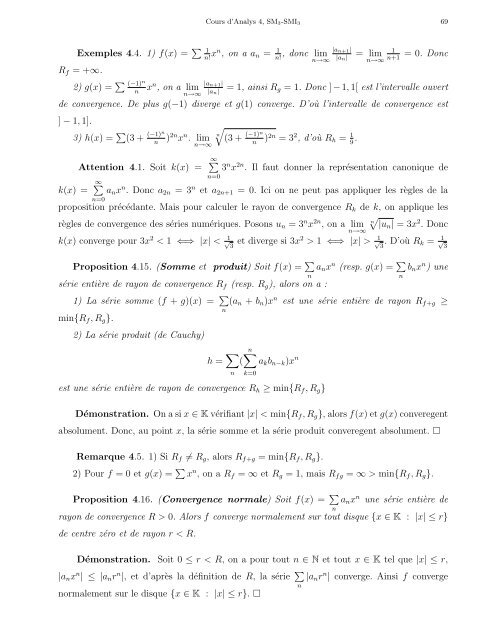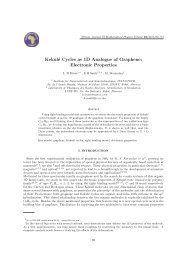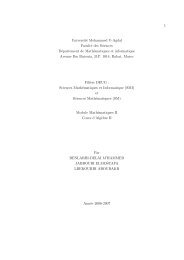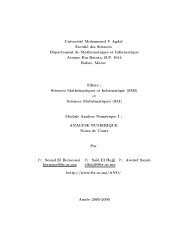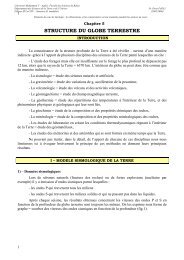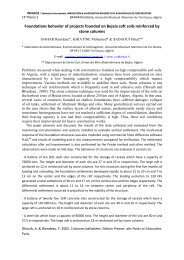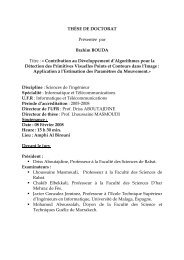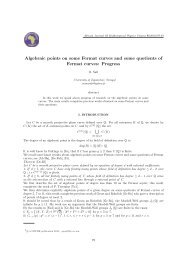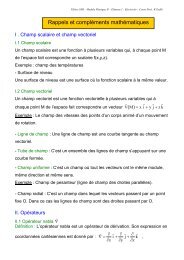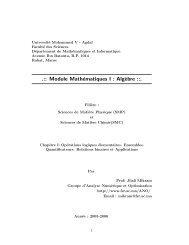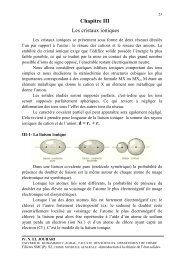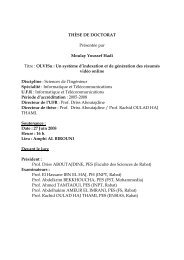Cours d'Analyse 4 - Faculté des Sciences Rabat
Cours d'Analyse 4 - Faculté des Sciences Rabat
Cours d'Analyse 4 - Faculté des Sciences Rabat
You also want an ePaper? Increase the reach of your titles
YUMPU automatically turns print PDFs into web optimized ePapers that Google loves.
<strong>Cours</strong> d’Analys 4, SM3-SMI3<br />
Exemples 4.4. 1) f(x) = 1<br />
n! xn , on a an = 1<br />
|an+1|<br />
, donc lim<br />
n! n→∞ |an|<br />
Rf = +∞.<br />
= lim<br />
n→∞<br />
1<br />
n+1<br />
69<br />
= 0. Donc<br />
2) g(x) = (−1) n<br />
n xn |an+1|<br />
, on a lim<br />
n→∞ |an| = 1, ainsi Rg = 1. Donc ] − 1, 1[ est l’intervalle ouvert<br />
de convergence. De plus g(−1) diverge et g(1) converge. D’où l’intervalle de convergence est<br />
] − 1, 1].<br />
3) h(x) = (3 + (−1)n<br />
n )2nxn <br />
n<br />
. lim (3 +<br />
n→∞<br />
(−1)n<br />
n )2n = 32 , d’où Rh = 1<br />
9 .<br />
Attention 4.1. Soit k(x) = ∞<br />
3nx2n . Il faut donner la représentation canonique de<br />
n=0<br />
k(x) = ∞<br />
anxn . Donc a2n = 3n et a2n+1 = 0. Ici on ne peut pas appliquer les règles de la<br />
n=0<br />
proposition précédante. Mais pour calculer le rayon de convergence Rk de k, on applique les<br />
règles de convergence <strong>des</strong> séries numériques. Posons un = 3nx2n <br />
n<br />
, on a lim |un| = 3x<br />
n→∞<br />
2 . Donc<br />
k(x) converge pour 3x 2 < 1 ⇐⇒ |x| < 1<br />
√ 3 et diverge si 3x 2 > 1 ⇐⇒ |x| > 1<br />
√ 3 . D’où Rk = 1<br />
√ 3<br />
Proposition 4.15. (Somme et produit) Soit f(x) = <br />
anxn (resp. g(x) = <br />
bnxn ) une<br />
série entière de rayon de convergence Rf (resp. Rg), alors on a :<br />
1) La série somme (f + g)(x) = <br />
(an + bn)xn est une série entière de rayon Rf+g ≥<br />
min{Rf, Rg}.<br />
2) La série produit (de Cauchy)<br />
h = n<br />
(<br />
n<br />
n<br />
k=0<br />
akbn−k)x n<br />
est une série entière de rayon de convergence Rh ≥ min{Rf, Rg}<br />
Démonstration. On a si x ∈ K vérifiant |x| < min{Rf, Rg}, alors f(x) et g(x) converegent<br />
absolument. Donc, au point x, la série somme et la série produit converegent absolument. <br />
Remarque 4.5. 1) Si Rf = Rg, alors Rf+g = min{Rf, Rg}.<br />
2) Pour f = 0 et g(x) = x n , on a Rf = ∞ et Rg = 1, mais Rfg = ∞ > min{Rf, Rg}.<br />
Proposition 4.16. (Convergence normale) Soit f(x) = <br />
anxn une série entière de<br />
rayon de convergence R > 0. Alors f converge normalement sur tout disque {x ∈ K : |x| ≤ r}<br />
de centre zéro et de rayon r < R.<br />
Démonstration. Soit 0 ≤ r < R, on a pour tout n ∈ N et tout x ∈ K tel que |x| ≤ r,<br />
|anxn | ≤ |anrn |, et d’après la définition de R, la série <br />
|anrn | converge. Ainsi f converge<br />
normalement sur le disque {x ∈ K : |x| ≤ r}. <br />
n<br />
n<br />
n<br />
n


